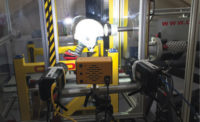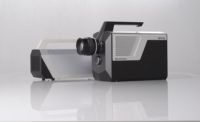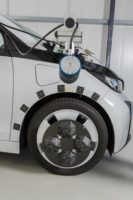When problems occur on a production line, the cause can often be difficult or impossible to identify. Mechanical errors can happen so quickly that it’s impossible for staff to intervene before there are interruptions, shutdowns, or wastage. When a line is producing at a cycle rate of, say, 100 pieces per minute, the human eye and brain simply can’t see or compute what’s going wrong.
As a consequence, at one time or another most plant operators will find themselves faced with the same puzzling questions: are production line glitches a consequence of tools or equipment wearing out, or products or operators on the line changing, or machine operating parameters needing adjustment, or productivity targets simply being unrealistic? The answer can often be found by using specialized high-speed recording cameras.
Unlike image processing cameras, which are used by plants as quality assurance to prevent the delivery of faulty parts, the job of high-speed cameras is to make production processes visible, enabling plant operators to document specific phases of the process. Detailed frame-by-frame analysis of photographic images can identify the causes of problems, leading quickly to solutions that bring the plant up to planned productivity levels. In many cases, a detailed visual investigation highlights opportunities for unforeseen process efficiency improvements with the result of boosting productivity even further.
High-speed recording cameras are now used successfully in a wide range of industries: filling systems for beverage production, presses for sheet metal processing, packaging machinery for food production, pharmaceutical labelling systems, robots in the automotive industry, and more besides. To see how, here we share three examples of real-world experience.
Cameras for all conditions
Production plants can be vast and divided into many different lines and processes such as molding, pressing, packaging, assembling, testing, labelling, crunching, and pick-and-place. A high-speed recording camera can usually be installed to monitor any of these processes and is typically relocated from one station to the next, wherever the production line isn’t working as it should. This means the cameras need to be small, mobile, and easy to set up. The camera’s field of view is determined by selection of the appropriate lens. Modern sensors make it possible to find the right combination of resolution, high frame rates and sensitivity.
High-speed recording cameras use a ring storage device which, when it is completely filled, is overwritten. When an error occurs on the production line, the camera is sent a signal—by a person watching the process, by a sensor connected to the camera, or when the camera detects a change in brightness in the image—and the recording is saved. The video material recorded up to that point remains on the internal memory and can be downloaded via an Ethernet port to a computer, in many cases a laptop kept nearby.
Alternatively, cameras are also available with an integrated large screen where videos can be viewed via a touch screen interface, edited, converted, and transferred to an SD card. This enables work on location without a computer. The cameras can be used for up to four hours without a mains power connection.
Enabling high-speed precision
In the pharmaceutical industry, perfect production and packaging of goods is absolutely vital, not only for a plant’s economic efficiency but also to comply with stringent regulations—and yet getting production machinery to run with faultless precision can be as challenging as in any other industry. Glass is often the best packaging material, with its inert chemical properties and ability to protect contained powders or liquids from the external environment, and is used widely for bottles, syringes, and ampoules—but when glass containers are travelling along a fast-moving production line, they can be easily broken. Shards of glass can fall into the production machinery or, worse, might even enter the medication itself on the production line.
One leading company that builds and sells packaging and production systems for the pharmaceutical industry (as well as cosmetics and other associated industries) is Bausch + Ströbel, which operates internationally from headquarters in Ilshofen, Germany, 50 miles northeast of Stuttgart. Bausch + Ströbel’s systems manufacture ampoules, bottles and vials, syringes, cartridges and insulin pens. Their machines produce up to 1,000 objects per minute, running fast not only for economic efficiency but also because at certain points in the production process there are flywheels that must maintain specific rotation speeds to develop the required centrifugal force. In such conditions, ampoules with necks of only 6.5 mm in diameter are filled by needles which plunge in and out of them in just 1146 milliseconds. If the line operates with even the tiniest inaccuracy, the ampoules are vulnerable to being under filled, overfilled (resulting in foam or splashing) or becoming broken. High-speed cameras have made it possible to diagnose precisely why such errors occur and the machine parameters can be adjusted accordingly.
At the next stage of the production process the ampoules move to a station for sealing, and once more they are at risk. The ampoule cap is heated and attached by a gripper, but if the ampoule is too far away from the flame, the heating takes too long, and if it’s too close, the heat is overly strong and the ampoule might not be sealed correctly. Here, too, a high-speed camera has allowed the machinery’s movements to be recorded at up to 1,000 frames per second and then played back in slow motion, where it can be precisely analyzed, enabling machine parameters to be reconfigured as required.
Jonas Bastian Gumb, one of the Bausch + Ströbel engineers who has worked with the cameras, explains that they serve another purpose, too: “Because we install production machinery for customers, the cameras make it possible for us to show them, in slow motion, how the systems work. They are amazed that you can see the processes going on in the machines in such detail.”
Frame-by-frame fault capturing
Varta Consumer Batteries, one of the largest battery producers in the world, is another company benefitting from high-speed cameras. Varta’s newest-generation batteries perform significantly better than rivals’ as a result of a specially formulated electrolyte, which is injected into the battery casing. The filling process requires precise dosing when only a few hundredths of a second are available, but at the company’s plant in Dischingen, near Munich in Germany, there were often problems with a missing electrolyte drop changing the battery characteristics and contaminating the production line. This was causing product rejections because of unacceptable fluctuations in the individual batteries’ performance, forcing expensive maintenance downtime on the production line.
By conducting slow-motion studies with high-speed recording cameras, it became possible to see how process parameters should be adjusted so that the high quality requirements could be met while maintaining a very short cycle time. Project engineer Josef Graule explains: “After making only a few high-speed recordings, we were able to select the filling jets in such a way that the filling process ran without any more troublesome splashes. Next, the camera provided us with information we could use to constantly reduce bottlenecks in the production flow.” Within the first year, investigations of more than 20 points in the production process led to a substantial number of optimizations.
Using cameras also enabled the setup at Varta’s factory of a continuous measurement inspection point. For the first time, a new laser measuring system for quality control could be precisely mounted because slow-motion video revealed the exact point on the batteries at which the measurement was to be made and at which point the measurement could be obtained with the system turning at full capacity. The camera’s integrated time-stamp function, which is applied to each individual frame, enables processes to be calibrated to the millisecond.
More than just leading to fixes for disruptive production line problems, then, high-speed cameras can also provide detailed information about machine behavior that can be used to prevent problems from occurring in the first place. Production line efficiency and quality control both benefit. As Jonas Bastion of Bausch + Ströbel says, “You have to see for yourself how these cameras work to fully appreciate them. Their value in plant management and quality control is really underestimated by many people.”




